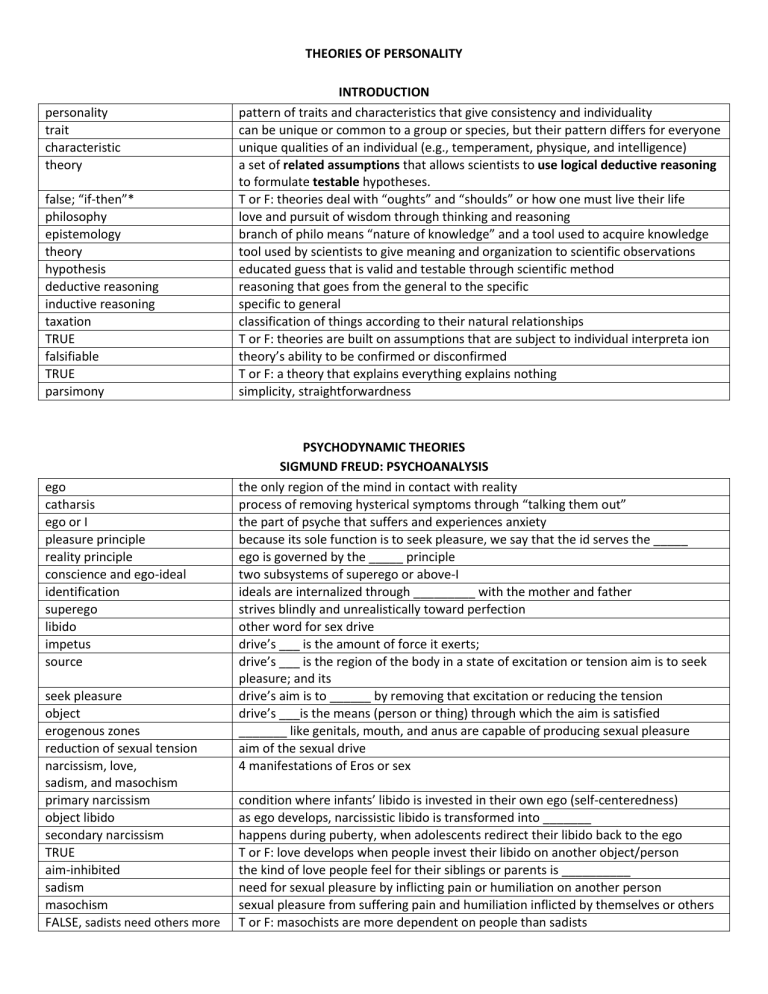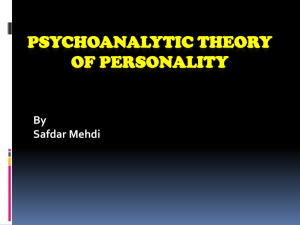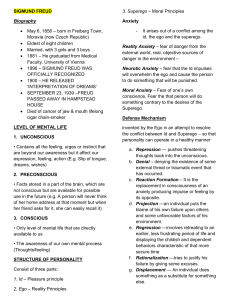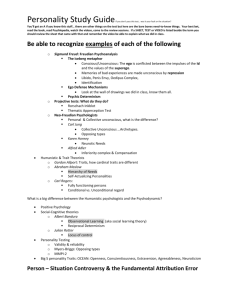
THEORIES OF PERSONALITY personality trait characteristic theory false; “if-then”* philosophy epistemology theory hypothesis deductive reasoning inductive reasoning taxation TRUE falsifiable TRUE parsimony ego catharsis ego or I pleasure principle reality principle conscience and ego-ideal identification superego libido impetus source seek pleasure object erogenous zones reduction of sexual tension narcissism, love, sadism, and masochism primary narcissism object libido secondary narcissism TRUE aim-inhibited sadism masochism FALSE, sadists need others more INTRODUCTION pattern of traits and characteristics that give consistency and individuality can be unique or common to a group or species, but their pattern differs for everyone unique qualities of an individual (e.g., temperament, physique, and intelligence) a set of related assumptions that allows scientists to use logical deductive reasoning to formulate testable hypotheses. T or F: theories deal with “oughts” and “shoulds” or how one must live their life love and pursuit of wisdom through thinking and reasoning branch of philo means “nature of knowledge” and a tool used to acquire knowledge tool used by scientists to give meaning and organization to scientific observations educated guess that is valid and testable through scientific method reasoning that goes from the general to the specific specific to general classification of things according to their natural relationships T or F: theories are built on assumptions that are subject to individual interpreta ion theory’s ability to be confirmed or disconfirmed T or F: a theory that explains everything explains nothing simplicity, straightforwardness PSYCHODYNAMIC THEORIES SIGMUND FREUD: PSYCHOANALYSIS the only region of the mind in contact with reality process of removing hysterical symptoms through “talking them out” the part of psyche that suffers and experiences anxiety because its sole function is to seek pleasure, we say that the id serves the _____ ego is governed by the _____ principle two subsystems of superego or above-I ideals are internalized through _________ with the mother and father strives blindly and unrealistically toward perfection other word for sex drive drive’s ___ is the amount of force it exerts; drive’s ___ is the region of the body in a state of excitation or tension aim is to seek pleasure; and its drive’s aim is to ______ by removing that excitation or reducing the tension drive’s ___is the means (person or thing) through which the aim is satisfied _______ like genitals, mouth, and anus are capable of producing sexual pleasure aim of the sexual drive 4 manifestations of Eros or sex condition where infants’ libido is invested in their own ego (self-centeredness) as ego develops, narcissistic libido is transformed into _______ happens during puberty, when adolescents redirect their libido back to the ego T or F: love develops when people invest their libido on another object/person the kind of love people feel for their siblings or parents is __________ need for sexual pleasure by inflicting pain or humiliation on another person sexual pleasure from suffering pain and humiliation inflicted by themselves or others T or F: masochists are more dependent on people than sadists death self-destruction anxiety realistic anxiety moral anxiety neurotic anxiety defense mechanism TRUE TRUE 1. repression 2. reaction formation 3. displacement 4. fixation 5. regression 6. projection 7. introjection 8. sublimation repression aim of the destructive drive is to return the organism to an inorganic state or ______ final aim of aggressive drive is _________ unpleasant state with physical sensation that warns us against impending danger ego superego and ego conflict originate from id (unconscious), unknown danger patterns of thought used by the ego to satisfy the id and superego T or F: only the ego can feel and produce anxiety T or F: the more defensive we are, the less psychic energy we have left to satisfy id defense mechanism keeps disturbing thoughts and impulses (id) from becoming conscious ALFRED ADLER: INDIVIDUAL PSYCHOLOGY Biography social interest Freud Adler BOTH Freud Adler Adler Freud Adler pneumonia Sigmund Adler physical deficiencies Individual Psychology a feeling of oneness with all humankind Freud or Adler: motivation = sex and aggression Freud or Adler: motivation = striving for superiority/success, social influences Freud or Adler: came from middle-class Viennese Jewish parents Freud or Adler: we have little choice in shaping our personality Freud or Adler: present behaviour is shaped by our view of the future Freud or Adler: each person is unique and indivisible Freud or Adler: placed very heavy emphasis on unconscious components of behavior Freud or Adler: inconsistent behavior does not exist Adler was sickly and nearly died of _______ who was Adler’s older brother For Adler, ______ formed the foundation for human motivation, not sex Adler founded the Society for Free Psychoanalytic Study which then became Society for Introduction striving for success/ superiority subjective perceptions unified and self-consistent social interest style of life creative power Adler’s 6 tenets 1. dynamic force behind people’s behaviour: 2. people’s _______ shape their behavior and personality. 3. personality is _____ and _______ 4. The value of all human activity must be seen from the viewpoint of ______ 5. self-consistent personality structure develops into a person’s ______ 6. (answer in #5) is modelled by people’s _____-- First Tenet: ________________________________________________________________________________________ striving for superiority dynamic power behind all motivation individual psychology _______ holds that everyone begins life with physical deficiencies which activate ____ feelings of inferiority feelings that motivate a person to strive for either superiority or success psychologically unhealthy _______ individuals strive for personal superiority psychologically healthy masculine protest striving for success final goal TRUE unifies personality; renders all behavior comprehensible creative power pain of inferiority feelings infancy success and social interest TRUE striving 4 success/social interest social progress _______ individuals seek success for all humanity will to power or a domination of others actions of people who are motivated by highly developed social interest Regardless of the motivation for striving, each individual is guided by a ________ T or F: the final goal fictional and has no objective existence why is the final goal significant? people’s ability to freely shape their behavior and create their own personality a person’s final goal reduces _______ earliest an individual can have (potential) drive toward growth, completion, success psychologically secure children strive toward superiority defined in terms of (2) T or F: physical deficiencies and having inferior body are viewed by Adler as a blessing ______ is innate but must be developed for people who strive for success, _____ is more important than personal credit Second Tenet: ______________________________________________________________________________________ fictions “expectations of the future” that shape how we act/strive for success/superiority subjective perception fictions is another term for ________ of reality teleogoly explanation of behavior in terms of its final purpose or aim; opposite of causality FALSE T or F: physical deficiencies cause a particular style of life Third Tenet: _______________________________________________________________________________ 1. organ dialect ways in which the entire person operates with unity and self-consistency 2. unity of conscious & uncon. organ dialect condition where deficient organ expresses the direction of the individual’s goal unconscious part of the goal that is not understood by the individual; not helpful in final goal conscious thoughts that are understood and seen as helpful in striving for success understands For Adler, the conscious and unconscious life depends on whether one _____ it or not Fourth Tenet: ________________________________________________________________________________ Gemeinschaftsgefuhl feeling of oneness with all humanity;membership in social community of all people social feeling/community feeling better translation for “social interest” are _________ and ____________ social interest attitude of relatedness with humanity in general and an empathy for each member of the human community social advancement social interest is manifested as cooperation with others for ___ not for personal gain social interest, adhesive _______ is the natural condition of humans and the _____ that binds society together mother-child relationship/infancy where does social interest originate? avoid emotional detachment what is the father’s role in child’s social environment and paternal authoritarianism FALSE T or F: All acts of philanthropy and kindness are motivated by Gemeinschaftsgefuhl social interest Adler’s yardstick for measuring psychological health “the sole criterion of human values” exaggerated;personal superiority psychologically unhealthy = ____ feelings of inferiority and compensate with ___ goal normal; high healthy = motivated by ___ feelings of incompleteness and ___ level of social interest neurotic and healthy 2 styles of life: Fifth Tenet: _______________________________________________________________________________________ style of life flavor of a person’s life includes goal, self-concept, feelings for others, and attitude toward the world product of the interaction of heredity, environment, and a person’s creative power 4 or 5 (answer above) is well established by age _____ TRUE T or F: the final goal is singular UNHEALTHY HEALTHY action 1. neighborly love 2. sexual love 3. occupation Healthy Healthy Healthy or Unhealthy: inflexible life; can’t choose new ways to react to environment Healthy or Unhealthy: constant final goal but perception continually changes Healthy style of life express social interest through ______ 3 major problems of life: Healthy or Unhealthy: actively struggle to solve major problems of life Healthy or Unhealthy: highest form of humanity in the evolutionary process Sixth Tenet: _______________________________________________________________________________________ TRUE T or F: people are responsible for who they are and how they behave creative power dynamic concept implying movement – the most salient characteristic of life TRUE T or F: people are creative beings who react, act, and cause environment to react FALSE T or F: heredity and environment primarily determines our personality the law of the low doorway Adler’s analogy regarding the use of creative power in solving life’s problems creative power _____ endows humans with the freedom to follow a useful or useless style of life. ALFRED ADLER: INDIVIDUAL PSYCHOLOGY Abnormal Development underdeveloped 1. set goals too high 2. live in own private world 3. rigid/dogmatic style of life TRUE private meaning 1. exagge. physical deficiencies 2. pampered style of life 3. neglected style of life feelings of inferiority selfish; defeat; success parasitic 1. extreme discouragement 2. indecisiveness 3. oversensitivity 4. impatience 5. exagge. emotion (anxiety) FALSE suspicious; dangerous to others safeguarding tendencies Conscious excuses, aggression, withdrawal excuses, “Yes, but” & “If only” 1. depreciation 2. accusation 3. self-accusation depreciation accusation self-accusation withdrawal 1. moving backward 2. standing still underlying factor in all types of maladjustments is an ________ social interest besides a lack of social interest, neurotics have 3 other characteristics T or F: the higher the goal, the more rigid the striving neurotics possess _______ where their view of the world differs from others 3 external factors in maladjustment the first external factor must be coupled with exaggerated __ to cause maladjustment people with 1st external factor are _____, and fear _____more than they desire _____ aside from weak social interest, pampered people want to keep their ___ relationship 5 characteristics of pampered people T or F: pampered people receive much love and do not feel neglected neglected people differ from pampered people because they are more ___ and ___ patterns of behavior created to protect exaggerated self-esteem from public disgrace Conscious or Unconscious: protective devices ^^^ 3 common protective devices or ______ are: ________, ________, and _________ most common safeguarding tendency and is expressed in ____ and ____ format aggression has 3 forms: tendency to undervalue other people’s achievements and overvalue one’s own tendency to blame others for one’s failures and to seek revenge devaluing themselves in order to inflict suffering on others using self-torture and guilt safeguarding through distance (running away from difficulties) withdrawal has 4 models: 3. hesitating 4. constructing obstacles moving backward standing still hesitating/hesitation constructing obstacles self-defeating FALSE TRUE masculine protest TRUE <3 TRUE psychologically reverting to a more secure period of life not moving in any direction, doing nothing, less severe than moving backward procrastinating, compulsive behaviors, leaving work unfinished are examples of _____ when people build a straw house to show that they can knock it down safeguarding tendencies are __ because they hinder authentic feelings of self-esteem T or F: psychic life of men and women are different T or F: a male-dominated society is an artificial product of historical development belief that men are superior to women T or F: Adler was a feminist T or F: children’s interpretations are more important than their chronological position PSYCHODYNAMIC THEORIES ALFRED ADLER: INDIVIDUAL PSYCHOLOGY FIRSTBORN YOUNGEST ONLY CHILD MIDDLE FIRSTBORN, ONLY CHILD YOUNGEST YOUNGEST ONLY CHILD FIRSTBORN FIRSTBORN MIDDLE FIRSTBORN MIDDLE ONLY CHILD early recollections TRUE FALSE self-deceptions inconsistent TRUE choose: FIRSTBORN, MIDDLE, YOUNGEST, ONLY CHILD F, M, or Y: high anxiety F, M, or Y: lack independence F, M, or Y: inflated self-concept F, M, or Y: highly competitive F, M, or Y: uncooperative F, M, or Y: problem children F, M, or Y: realistically ambitious F, M, or Y: compete against parents F, M, or Y: fights for acceptance F, M, or Y: good organizer F, M, or Y: easily discouraged F, M, or Y: highly critical of others F, M, or Y: cooperative F, M, or Y: socially mature subjective account of ___yields clues to understanding final goal and style of lifE T or F: current style of life shapes and colors early recollections T or F: early experience determines our style of life Dreams are ____ and make self-interpretation more difficult a dream is more deceiving if the individual’s goal is _____ with reality T or F: dreams reveal the style of life analytical psychology analytical psychology analytical psychology collective unconscious archetypes self-realization 1. conscious 2. personal unconscious 3. collective unconscious ego self psychological imbalance personal unconscious complexes collective unconscious CARL JUNG: ANALYTICAL PSYCHOLOGY occult phenomena can and do influence the lives of everyone repressed experiences and experiences inherited from our ancestors motivate us psychology of opposites elements that come down to us from our ancestors but not experienced individually innate patterns of thought and behavior that strive for realization in our environment process of becoming an individual or whole person can be achieved through balance between various opposing forces of personality 3 levels of the psyche TRUE FALSE complexes; archetypes archetypes instinct; archetype repeated experiences dreams TRUE center of consciousness, but not the core of personality center of personality that is largely unconscious overemphasis on expanding the conscious psyche can lead to _____ all repressed or forgotten experiences of one particular individual emotionally toned conglomeration of associated ideas ( ex. “mother” sparks emotion) humans’ innate tendency to react in a particular way whenever their experiences stimulate a biologically inherited response tendency T or F: innate potential requires individual experience for it to be activated T or F: collective unconscious are inherited ideas _______ are individualized while _______ are generalized (fr collective unconscious) emotionally-toned collection of ancient images derived from collective unconscious ___ is the unconscious physical impulse toward action while ____ is its psychic ver. archetypes are biological and originate through the ______ of humans’ early ancestor main source of archetypal material; produce motifs that coincide with ancient ppl T or F: hallucinations of psychotic patients offer evidence for universal archetypes Archetypes persona puppet shadow darkness, repression test of courage anima TRUE side of personality that people show to the world or is dictated by society when we over identify with our ^ we become society’s _____ qualities we don’t acknowledge but attempt to hide from ourselves and others this ^ is the archetype of ______ and ______ striving to know our ^ is our first ______ feminine side of personality, “soul” T or F: men recognize their anima once they get comfortable with their shadow anima animus anima and animus great mother rebirth wise old man FALSE TRUE life hero ideal personality TRUE self perfection; mandala self-realization comscious; personal, collective Dynamics of Personality causality teleology progression regression progression regression influence man’s feeling side; explanation for certain irrational moods and feelings. masculine archetype in women that symbolize thinking and reasoning appears in dreams, visions, and fantasies in a personified form associated with fertility and nourishment as well as power and destruction fertility and power combine to form the concept of ________ archetype of wisdom and meaning; preexisting knowledge of life’s mysteries T or F: the collective unconscious can directly impart its wisdom to an individual T or F: archetypes are always emotionally tinged symbol of wise old man powerful person who fights against great odds to vanquish evil but has a weakness this ^ archetype is our model for the _____ and represents victory over darkness T or F: an immortal person with no weakness cannot be a hero the archetype of archetypes that pulls together the other archetypes and unites them ^ is symbolized by person’s ideas of _____ but its ultimate symbol is ______ archetypes are united through the process of _________ ego represents ____ only while the self includes both ____ and ______ images CARL JUNG: ANALYTICAL PSYCHOLOGY holds that present events have their origin in previous experiences. holds that present events are motivated by goals and aspirations for the future adaptation to the outside world involving the forward flow of psychic energy adaptation to the inner world relying on a backward flow of psychic energy inclines a person to react consistently to a given set of environmental conditions activates the unconscious psyche 8 Psychological Types (2 attitudes x 4 functions) attitude (introverted/extraverted) predisposition to act or react in a characteristic direction (psychic energy) introversion turning inward of psychic energy with an orientation toward the subjective extraverted turning outward of psychic energy with an orientation toward the objective TRUE T or F: introverts perceive the external world selectively and subjectively their surroundings extraverts are more influenced by _____ more than their inner world TRUE T or F: healthy people attain a balance between their internal and their external world attitude, function if _____ is the orientation/direction, _____ is how we perceive information sensation receives physical stimuli and transmits them to perceptual consciousness perception of sensory impulses thinking logical intellectual activity that produces a chain of ideas feeling process of evaluating an idea or event the evaluation of every conscious activity intuition perception beyond the workings of consciousness may add or subtract elements from conscious sensation sensing, intuition based on the perception of absolute elementary facts choose from 8 personality types extraverted sensing perceive external stimuli objectively, the same way they exist in reality introverted sensing guided by their interpretation of sense stimuli not the stimuli themselves introverted sensing in excess may lead to hallucinations extraverted thinking Charles Darwin extraverted thinking scientists, accountants, mathematicians introverted thinking Immanuel Kant introverted thinking wonderful learners, bad teachers extraverted feeling expressing feelings in traditional/appropriate ways; thrive in social settings introverted feeling Subjective movie critics, art appraisers IT or EI extraverted thinking introverted thinking extraverted feeling extraverted feeling introverted feeling introverted feeling introverted sensing introverted sensing extraverted intuitive extraverted intuitive introverted intuitive introverted intuitive introverted intuitive superior, secondary, 2 inferior Development of Personality individuation/self-realization 35 or 40 childhood, youth, middle life, old age early morning sun full of potential lack brilliance (consciousness) problem-free morning sun puberty – middle life unaware of impending decline early afternoon sun brilliant but headed for sunset evening sun dimmed consciousness TRUE anarchic, monarchic, dualistic anarchic phase monarchic phase monarchic phase dualistic phase dualistic phase dualistic phase youth conservative principle middle life old age death inventors rely heavily on concrete thoughts objective thoughts + internal meaning use objective data to make evaluations businessmen, politicians value judgments are based on subjective perceptions rather than objective facts make people uncomfortable with their indifference to the objective world portrait artists give subjective interpretation to phenomena and can communicate meaning to others perceive facts in the external world subliminally (not fully sensing) guided by hunches and guesses because they inhibit distracting sensory data. guided by unconscious perception of facts that don’t resemble external reality surrealist artist religious fanatics, prophets, mystics hierarchy of functions personality develops through a series of stages that culminate in ________ Jung emphasized the second half of life, the period after age _____ 4 stages of life childhood youth middle life old age T or F: people must learn to find new meaning in their declining years of life substages of childhood chaotic and sporadic consciousness, no connection between islands of consciousness ego, logical, and verbal thinking begins to develop children refer to themselves in third person ego as perceiver is divided into objective and subjective (ego-complex) children refer to themselves in first person islands of consciousness become continuous land inhabited by ego-complex period of increased activity, maturing sexuality, growing consciousness desire to live in the past period of increasing anxieties and potential period where diminution of consciousness occurs Jung believed that ____ is the goal of life Self-Realization and Methods of Investigation TRUE T or F: self-realization involves elevating all four of the functions to a superior position unconscious Self-realization is achieved by people who can assimilate their __ into their personaliy middle life self-realization isn’t achieved before ______ inflating the ego expanding consciousness means ______ complexes purpose of word association test is to uncover _______ dreams active imagination active imagination dream analysis active imagination catharsis interpret, explain, elucidate education as social beings transformation confession of a pathogenic secret (catharsis) interpret, explain, elucidate educate them as social beings transformation transference countertransference our unconscious and spontaneous attempt to know the unknowable person begins with any impression and concentrate until it begins to “move.” purpose it to reveal archetypal images emerging from the unconscious purpose it to reveal the unconscious and unite it with the conscious images are from conscious state of mind, thus, clear and reproducible 4 approaches of Jung to therapy object relations theory focus on the first 4-6 months after birth and mother-child relationship role of early fantasy in the formation of interpersonal relationships hunger, sex, etc. any person, part of a person, or thing through which the aim is satisfied Object relations theory is an offspring of Freud’s ________ object relations theory place importance on _________ of interpersonal relationships object relations theory stress the ________ and _____ of the mother. prime motive of human behaviour (2) infants’ inherited predisposition to reduce anxiety from life instinct and death instinct. psychic representations of unconscious id instincts; infants’ image of “good” & “bad” hungry infants who cry and kick their legs are phantasizing of destroying the ______ child’s wish to destroy one parent and sexually possess the other phantasies are u_____ and can be c________ infants take external objects into their psychic structure ____ objects are fantasies of internalizing the object in concrete and physical terms sexual instincts, drive to live, and basic instinctual impulses (thirst and hunger) negative feelings like hate, anger, and aggression as the ego moves toward __, infants prefer gratifying sensations over frustrating ones ways of dealing with both internal and external objects; like stages of development position that includes both paranoid feelings of being persecuted and a splitting of internal and external objects into the good and the bad during ^^, the ego’s perception of external world is ________ and _______ the first position is developed during the first ____ months of life feelings of anxiety over losing a loved object coupled with a sense of guilt for wanting to destroy that object occurs when infant begins to view external objects as whole and see that good and bad can exist in the same person this position ^^ begins around ___ month seeing their mother as whole and also as being endangered helps them feel _____ T or F: depressive position is resolved when child recognizes mother will return when the depressive position is resolved, children __ between good and bad mother fantasy of taking into their body perceptions and with the external object (breast) when dangerous objects are introjected, they become ________ drive object (breast, penis, vagina) instinct theory consistent patterns intimacy and nurturing human contact and relatedness phylogenetic endowment phantasies bad breast Oedipus complex unconscious; contradictory introjection introjected life instinct (Eros, libido) death instinct (Thanatos) integration positions paranoid-schizoid subjective and fantastic 3-4 months depressive position 5 or 6th empathy TRUE close the split introjection internal persecutors for patients who only need to share their secrets give patient insight on the causes of their neuroses, but doesn’t solve social problems make patients socially well adjusted therapist must first be healthy to help patients move toward individuation in midlife patient transfers feelings onto therapist therapist transfers feelings onto patient MELANIE KLEIN: OBJECT RELATIONS THEORY projection project onto external objects projection splitting excessive splitting projective identification projection; projective identification projective identification fantasy that one’s own feelings and impulses actually reside in another person to alleviate enxiety of beung destroyed by internal persecutors, infants will _______ when a girl fantasizes devouring her mother then fears mom will be the one to do so keeping apart incompatible impulses to deal with pleasurable & destructive impulses may lead to pathological repression splitting off unacceptable parts of oneself, project them into another object, and finally introject them back into themselves in a changed or distorted form ____ exists in phantasy while _____ exists in real interpersonal relationships a man is excessively submissive to force his wife to display his dominating tendency MELANIE KLEIN: OBJECT RELATIONS THEORY Internalizations ego FALSE, unorganized* feeding milk, love, security TRUE breast disintegration split superego terror libido ego; superego anxiety; guilt superego Oedipus complex genital stage penis envy FALSE, strong* TRUE castration anxiety sexual intercourse sense of self; helps control impulses to act out in socially inappropriate ways T or F: the ego is organized at birth, can feel anxiety, and use defense mechanism the ego begins to evolve with infant’s first experience with ____ the mother’s breast fills the infant with ____, _____, and _______ T or F: even experiences unrelated to feeding are evaluated by ego as good/bad breast infant’s first object relation which becomes prototype for later interpersonal relations breakdown of the psyche that can occur during intense emotional distress or trauma before a unified ego can emerge, it must first become _____ to avoid disintegration arouses guilt, anxiety, inferiority feelings; regulate relationship w/ internalized objects early superego produces _____, not guilt to manage their anxiety, child’s ego mobilizes ___ or life instinct against death instinct while the _______ is linked to external world, the _____ is more on regulating internal By the 5th or 6th year, the superego arouses little ____ but a great measure of _____ ________ emerges as realistic guilt after the Oedipus complex is resolved describes child's early relationship with their parents (esp. opposite-sex parent) this stage ^^ climaxes during the _____ around 3 or 4 years old _____ stems from girl’s wish to internalize father’s penis and receive baby from him T or F: during the Oedipal period, girls maintain a weak attachment to their mother T or F: boy must have a good feeling about father’s penis before he can value his own fear of being castrated as oral-sadistic impulses of child are projected onto the father Oedipus complex is resolved when child is able to allow parents to have _____ KAREN HORNEY: PSYCHOANALYTIC SOCIAL THEORY 177 Key Terms and Concepts ∙ Horney insisted that social and cultural influences were more important than biological ones. ∙ Children who lack warmth and affection fail to meet their needs for safety and satisfaction. ∙ These feelings of isolation and helplessness trigger basic anxiety, or feelings of isolation and helplessness in a potentially hostile world. ∙ The inability of people to use different tactics in their relationships with others generates basic conflict: that is, the incompatible tendencies to move toward, against, and away from people. ∙ Horney called the tendencies to move toward, against, or away from people the three neurotic trends. ∙ Healthy people solve their basic conflict by using all three neurotic trends, whereas neurotics compulsively adopt only one of these trends. ∙ The three neurotic trends (moving toward, against, or away from people) are a combination of 10 neurotic needs that Horney had earlier identified. ∙ Both healthy and neurotic people experience intrapsychic conflicts that have become part of their belief system. The two major intrapsychic conflicts are the idealized self-image and self-hatred. ∙ The idealized self-image results in neurotics’ attempts to build a godlike picture of themselves. ∙ Self-hatred is the tendency for neurotics to hate and despise their real self. ∙ Any psychological differences between men and women are due to cultural and social expectations and not to biology. ∙ The goal of Horneyian psychotherapy is to bring about growth toward actualization of the real self.







